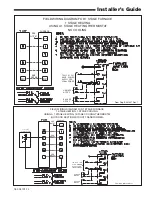
10
18-CD21D1-12
Installer’s Guide
DUCT CONNECTIONS
Air duct systems should be installed in accordance
with standards for air conditioning systems, National
Fire Protection Association Pamphlet No. 90. They
should be sized in accordance with ACCA Manual D
or whichever is applicable. Check on controls to make
certain they are correct for the electrical supply.
Central furnaces, when used in connection with cool-
ing units, shall be installed in parallel or on the up-
stream side of the cooling units to avoid condensation
in the heating element, unless the furnace has been
specifically approved for downstream installation.
With a parallel flow arrangement, the dampers or oth-
er means used to control flow of air shall be adequate
to prevent chilled air from entering the furnace, and if
manually operated, must be equipped with means to
prevent operation of either unit unless the damper is
in full heat or cool position.
On any job, flexible connections of nonflammable ma-
terial may be used for return air and discharge con-
nections to prevent transmission of vibration. Though
these units have been specifically designed for quiet,
vibration free operation, air ducts can act as sounding
boards and could, if poorly installed, amplify the slight-
est vibration to the annoyance level.
When the furnace is located in a utility room adjacent
to the living area, the system should be carefully de-
signed with returns which minimize noise transmis-
sion through the return air grille. Although these
winter air conditioners are designed with large blow-
ers operating at moderate speeds, any blower moving
a high volume of air will produce audible noise which
could be objectionable when the unit is located very
close to a living area. It is often advisable to route the
return air ducts under the floor or through the attic.
Such design permits the installation of air return re-
mote from the living area (i.e. central hall).
When the furnace is installed so that the supply ducts
carry air circulated by the furnace to areas outside the
space containing the furnace, the return air shall also
be handled by a duct(s) sealed to the furnace and ter-
minating outside the space containing the furnace.
Minimum return air “entering temperature” for
the furnace is 55° F.
Where there is no complete return duct system, the re-
turn connection must be run full size from the furnace
to a location outside the utility room, basement, attic,
or crawl space.
NOTE: DO NOT install return air through the
back of the furnace cabinet.
RETURN AIR DUCT CONNECTION
NOTE:
On upflow 5 or 6 ton airflow models, if the airflow re-
quirement exceeds 1800 CFM, these models will re-
quire return air openings and filters on both sides; OR
1 side and the bottom; OR just the bottom.
▲
WARNING
!
TO PREVENT INJURY OR DEATH DUE TO CONTACT
WITH MOVING PARTS, TURN THE POWER TO THE
FURNACE OFF BEFORE SERVICING FILTERS.
inlet duct, add to cut where indicated by solid lines
in Figure 12. Cut corners diagonally and bend out-
ward to form flange.
6. If flanges are not required, and a filter frame is
installed, cut between the locating notches. See
Figure 12.
7.
Upflow Furnaces:
Two clips are factory supplied
for bottom or side return. Use the filter rack on ei-
ther side or on the bottom if the filter is to be used
within the furnace cabinet.
▲
WARNING
!
Do NOT install the filter in the return duct directly
above the furnace in horizontal applications. Install
the filter remotely. Installing the filter directly above
the furnace in horizontal applications may cause
property damage, serious injury or death.
All return air duct systems should provide for installa-
tion of return air filters.
PREPARATION FOR UPFLOW BOTTOM AND SIDE
RETURN AIR FILTER INSTALLATION
All return air duct systems should provide for installa-
tion of return air filters.
1. Determine the appropriate postion to set the fur-
nace in order to connect to the supply and return
ductwork.
2. The return air filter are shipped in either the
bottom or side location. Remove the filter by first
turning the two latches on the blower door and tilt-
ing the door forward to remove. Remove the filter
by sliding it out.
3. For upflow side return installations, remove the
insulation around the opening in the blower com-
partment.
4. The side panels of the upflow furnace include
locating notches that are used as guides for cutting
an opening for return air, refer to Figure 12 and
the outline drawing on page 5 for duct connection
dimensions for various furnaces.
5. If a 3/4" flange is to be used for attaching the air
























